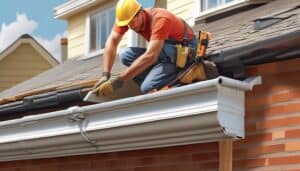K-style gutters attach to the fascia board. This features a crown moulding-like design, making them stylish and easy to install. They are typically made from aluminium, copper, vinyl, and steel. This is suitable for most residential applications.
Box gutters, integrated beneath roof shingles, blend seamlessly into architecture. They are ideal for commercial or historical properties. They handle substantial water flow but require more frequent maintenance. Usually made from copper or stainless steel, box gutters can be customized to match the roof material.
Understanding these distinctions can guide you toward the best choice for your needs.
By exploring the pros and cons of k style vs Box gutters, we aim to provide you with the necessary information. This is to make an informed decision that best suits your home’s requirements and your personal preferences.
Let’s delve into the world of gutter types and discover which style could be the ideal fit for your property.
Key Takeaways
- Most homes choose K-style gutters. They look nice and are easier to care for.
- Box gutters are often used in commercial buildings. They are wider and deeper.
- K-style gutters last a long time, but they can cost more. Box gutters are cheaper.
- You can easily install K-Style gutters yourself since they have standard sizes.
- Box gutters might need a pro to install. They often require custom work.
What Are the Key Differences in Designs of Box vs K-Style Gutters?
K-style gutters and box gutters differ primarily in design, installation, and application suitability.
Box gutters, also known as concealed gutters. They are integrated beneath roof shingles during construction, blending seamlessly into the architecture. This makes them ideal for commercial buildings or historical properties where aesthetic continuity is crucial. Box gutters are larger and handle substantial water flow efficiently.
K-style gutters attach directly to the fascia board, simplifying installation and maintenance. Their crown molding-like design adds architectural elegance to residential properties. Available in materials like aluminium, copper, vinyl, and steel. K-style gutters offer versatility in appearance and functionality. They come in 5 and 6-inch sizes, suitable for most residential applications.
K-style gutters are durable, with an angular shape that withstands debris weight without detachment. However, their complex shape can trap debris, making cleaning more challenging compared to box gutters.
The choice between these gutter types depends on the needs of the building and the style you like.
What Are K style Gutters?
K-style gutters, also known as Ogee gutters. They are popular for their decorative crown moulding-like appearance and are made of aluminium. They come in 5 and 6-inch sizes, handling water but retaining water longer than box gutters, which can lead to cleaning challenges.
K-style gutters have a decorative appearance resembling crown moulding. This makes them distinct from Box gutters. They are easier to clean due to their sleek shape and appeal to many homeowners with their modern look. These gutters are widely used in residences for their durability, high water capacity, and easy installation.
How Are K-Style Gutters Designed?
K-style gutters are designed with a distinctive shape. This is to resemble the letter ‘K’ for efficient water drainage and added visual appeal. They feature minimal seams to reduce leaks and clogs. And will ensure a reliable water management system.
Available in materials such as aluminium, vinyl, steel, and copper, they offer a range of options for both design and functionality.
What Are The Advantages Of K-Style Gutters?
K-style gutters offer a combination of decorative elegance, durability, and easy installation. Made from durable aluminium, they come in 5 and 6-inch sizes for optimal water capacity and efficient water drainage solutions.
What Are The Disadvantages Of K-Style Gutters?
K-style gutters are prone to debris accumulation, leading to frequent cleaning needs and an increased risk of clogs and leaks. Seamless K-style gutters can be challenging to install. They are often requiring professional expertise for optimal performance.
What Are Box Gutters?
Box gutters are wider and deeper than K-Style gutters, providing a substantial trough for water flow. They lack decorative edges but are easier to clean and maintain. Commonly used in commercial properties. However, modern box style gutters can also be tailored for residential buildings.
Their seamless integration into the roofline offers a clean look and efficient handling of larger water volumes.
What Materials Are Used For Box Gutters?
Aluminium, steel, vinyl, and wood are commonly used for box gutters. Providing durability and a box-like shape that distinguishes them from traditional K-style gutters. These materials enhance the strength and longevity of box gutters. This makes them efficient for managing water runoff.
What Are The Advantages Of Box Gutters?
Box gutters outperform K-Style gutters in water transportation capacity due to their deep and wide troughs. They are simpler to clean and are commonly found in commercial buildings. They offer flexibility in size, material, and colour options.
What Are The Disadvantages Of Box Gutters?
Box gutters require more maintenance due to their design complexity, making them prone to debris buildup. They are not ideal for steep roofs because water flow can be affected by the roof pitch. Inadequate size can lead to overflow and water damage if not properly installed to handle heavy rainfall.
How Do Maintenance Needs and Longevity Differ Between K Style and Box Gutters?
K-style gutters are easier to maintain than Box gutters due to their simpler design with fewer seams. The longevity of K-Style gutters. Especially when made from durable materials like aluminium, steel, or copper, is notable.
Box gutters may require more frequent maintenance due to their intricate design with more seams that can trap debris. However, with proper care, both gutter styles can offer lasting durability.
Regular cleaning and inspections are essential. This is to ensure gutters endure over time and function for your home’s square footage.
How Do You Choose the Right Gutter System?

Choosing the right gutter system involves evaluating both functional needs and aesthetics.
For residential buildings, K-style gutters are ideal. This is due to their durability, ease of installation, and moderate water-handling capacity. They are attached directly to the fascia board and have a crown molding-like appearance that enhances home aesthetics.
For commercial properties or areas with heavy rainfall, box guttering systems are more suitable. They handle large amounts of water and sit under roof shingles, which makes them look nice. However, they may require more frequent maintenance due to their concealed nature.
To choose the right gutter system, think about the looks, how it manages water, and how hard it is to install.
What Factors Should Be Considered When Choosing Between K Style And Box Gutters?
The style of your home and the weather where you live should guide your choice of gutters. Traditional homes may benefit from the classic look of K-style gutters. While regions with heavy rainfall may require the higher water-handling capacity of Box gutters.
How Does The Architectural Style Of A Home Impact The Decision For K Style Vs Box Gutters?
The architectural style of your home significantly influences the choice between Box gutters vs style gutters. This affects the overall aesthetic appeal. Modern homes may benefit from Box gutters’ sleek look. While historic residences often pair well with the classic appeal of K-style gutters. Matching gutter styles to the architectural design enhances visual harmony.
How Do Local Climate Conditions Affect The Choice Between K Style And Box Gutters?
In regions with heavy rainfall, Box gutters are more suitable due to their larger capacity. In areas with moderate rainfall, K-Style gutters are sufficient. Consider the roof pitch and drainage areas to choose the gutter system. This offers optimal protection against extreme weather conditions in your locality.






